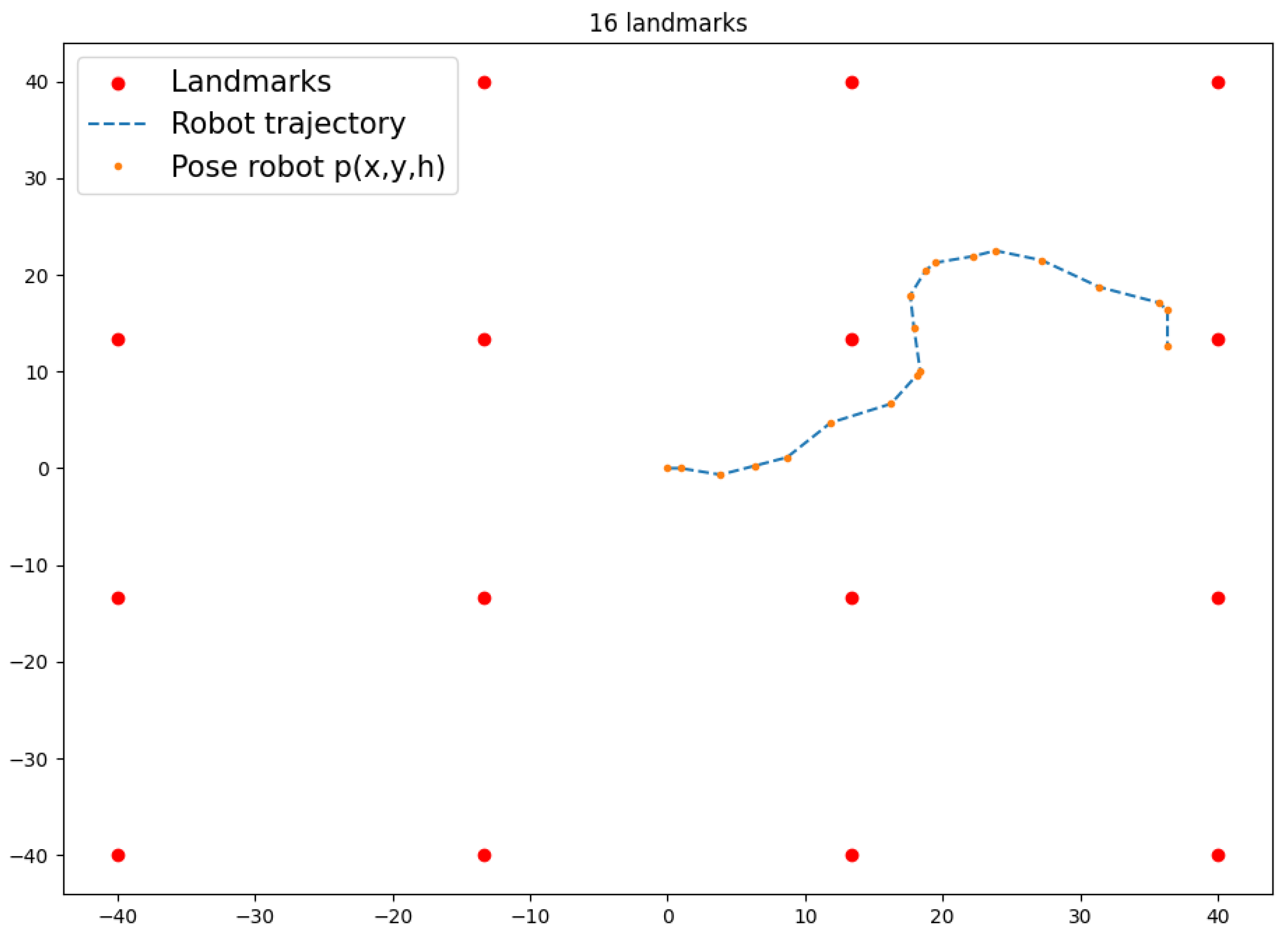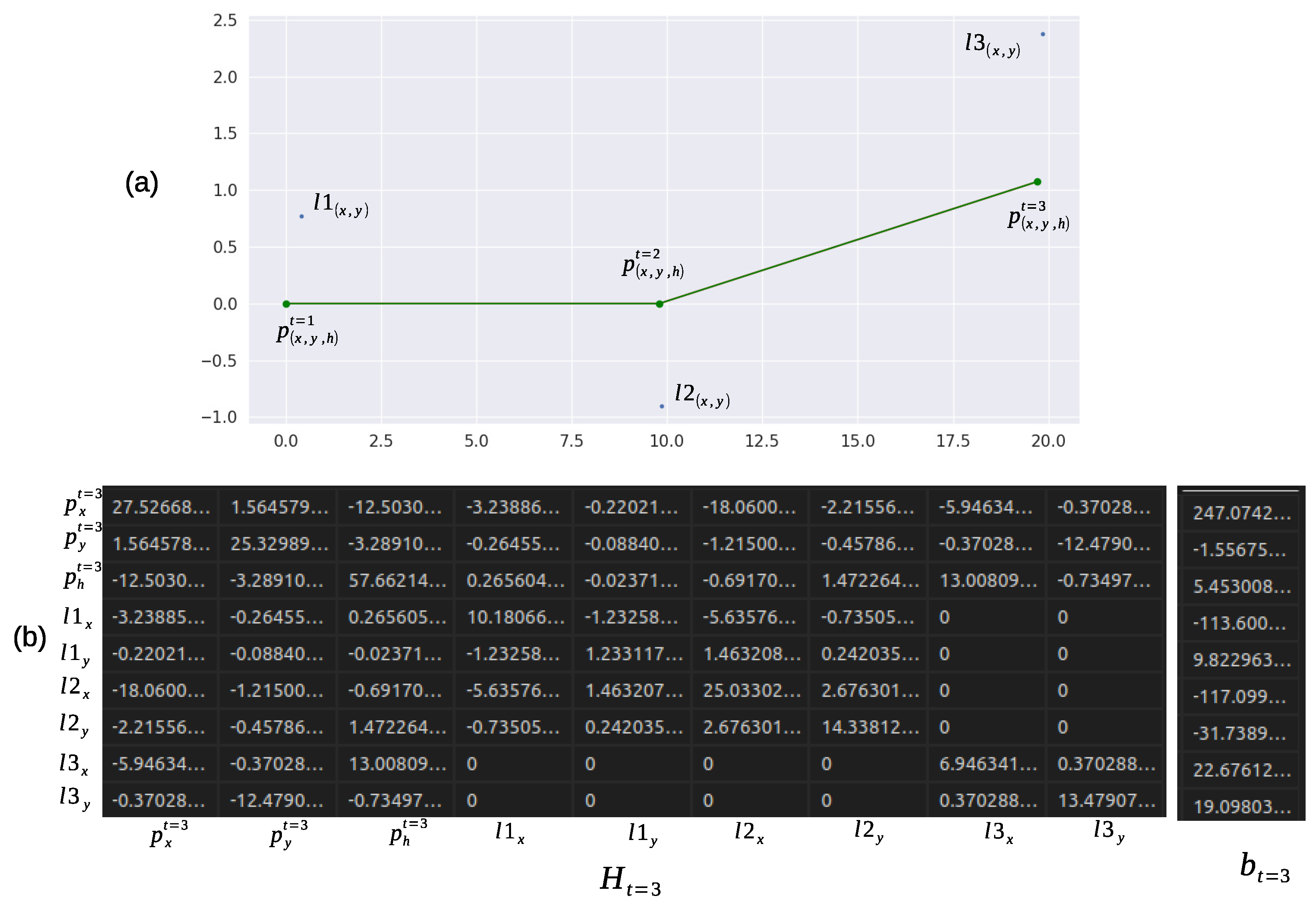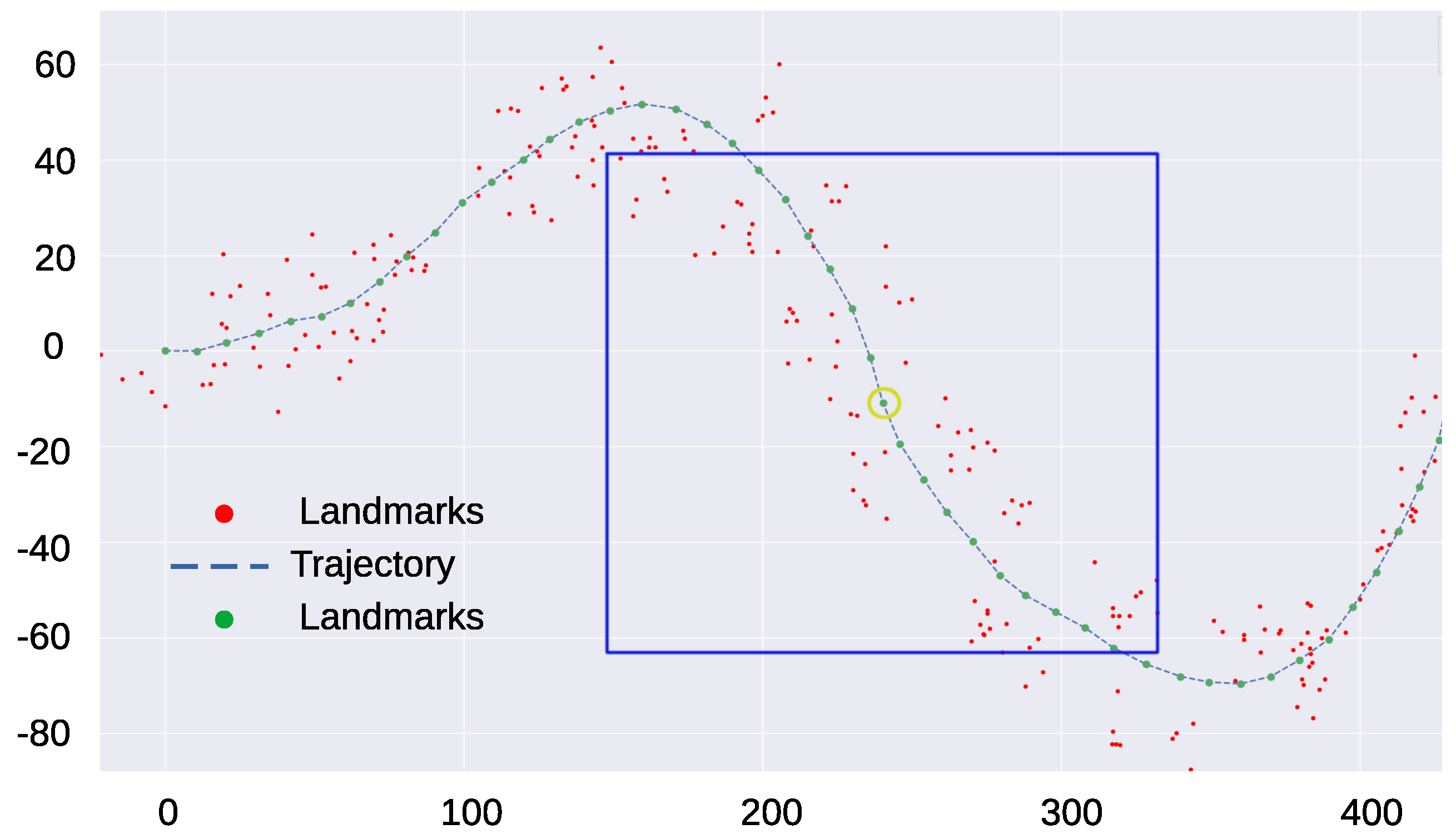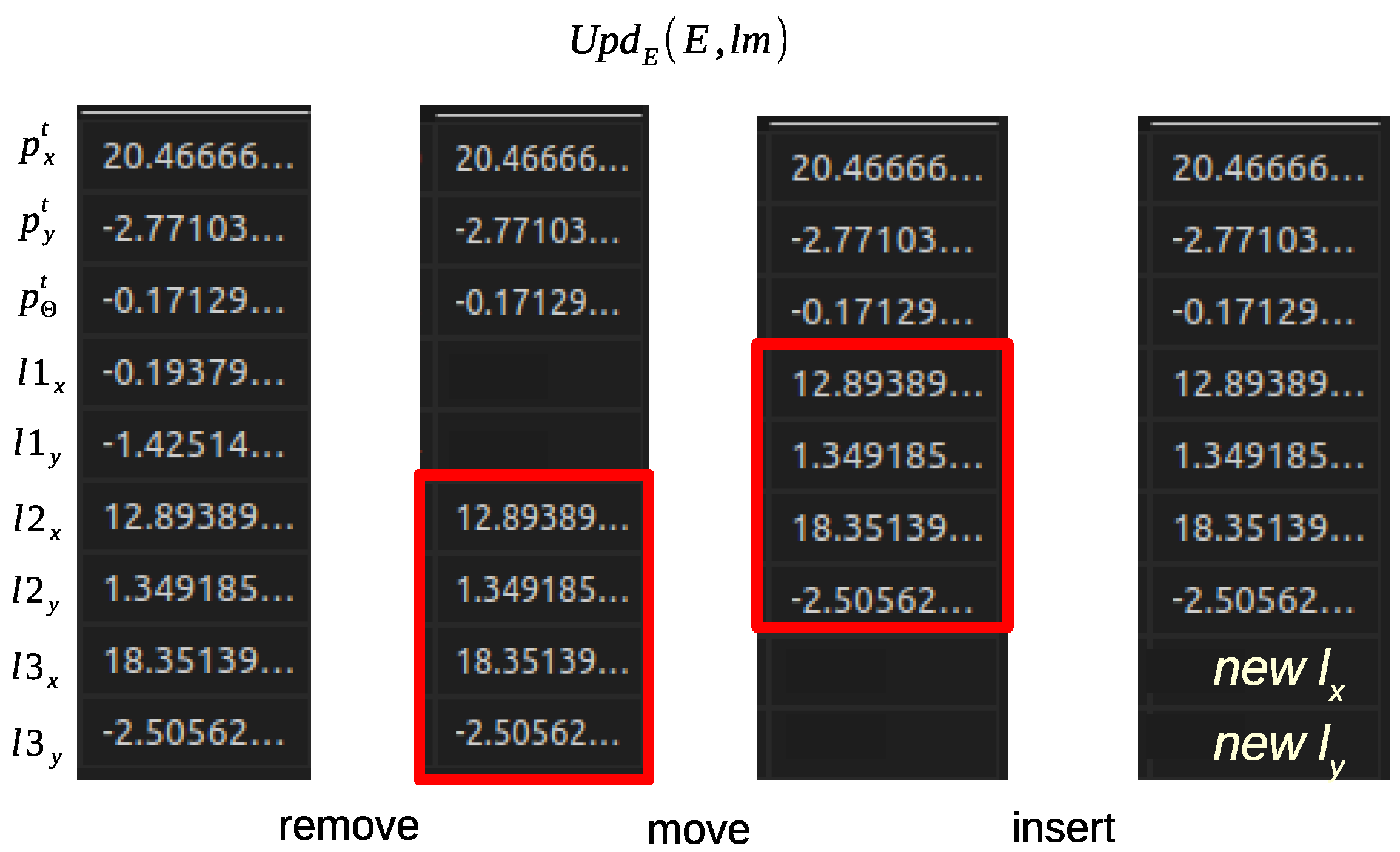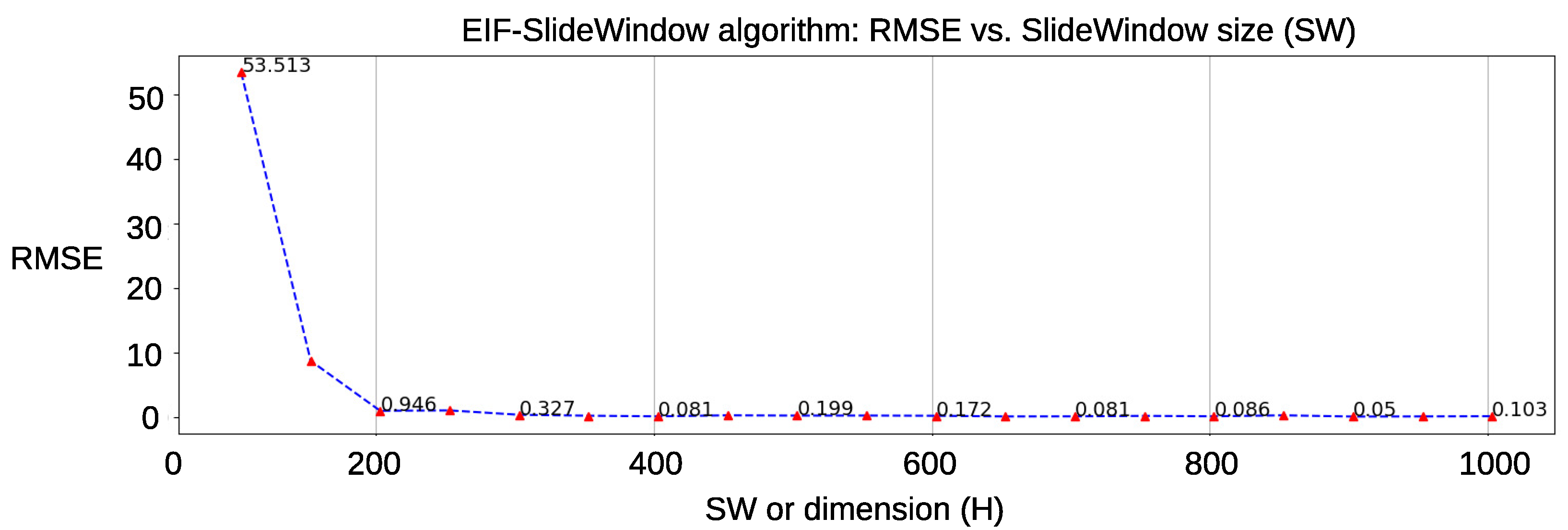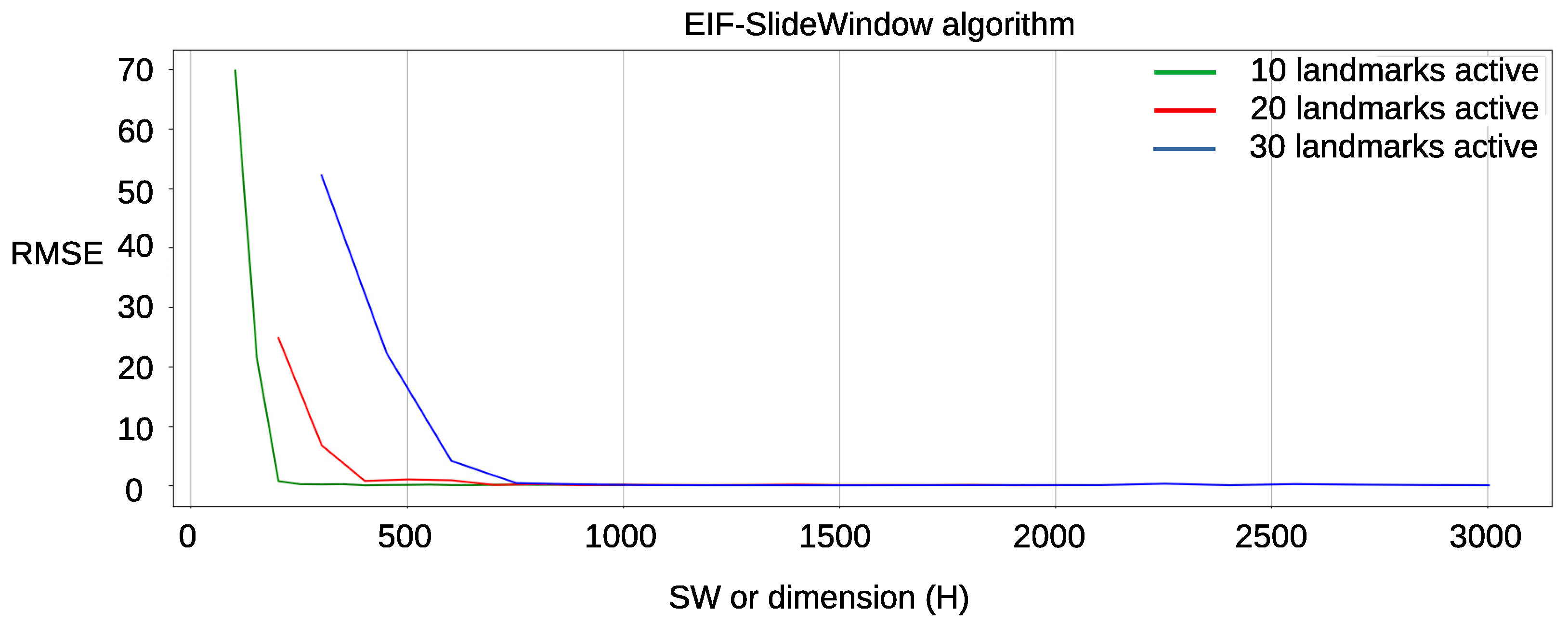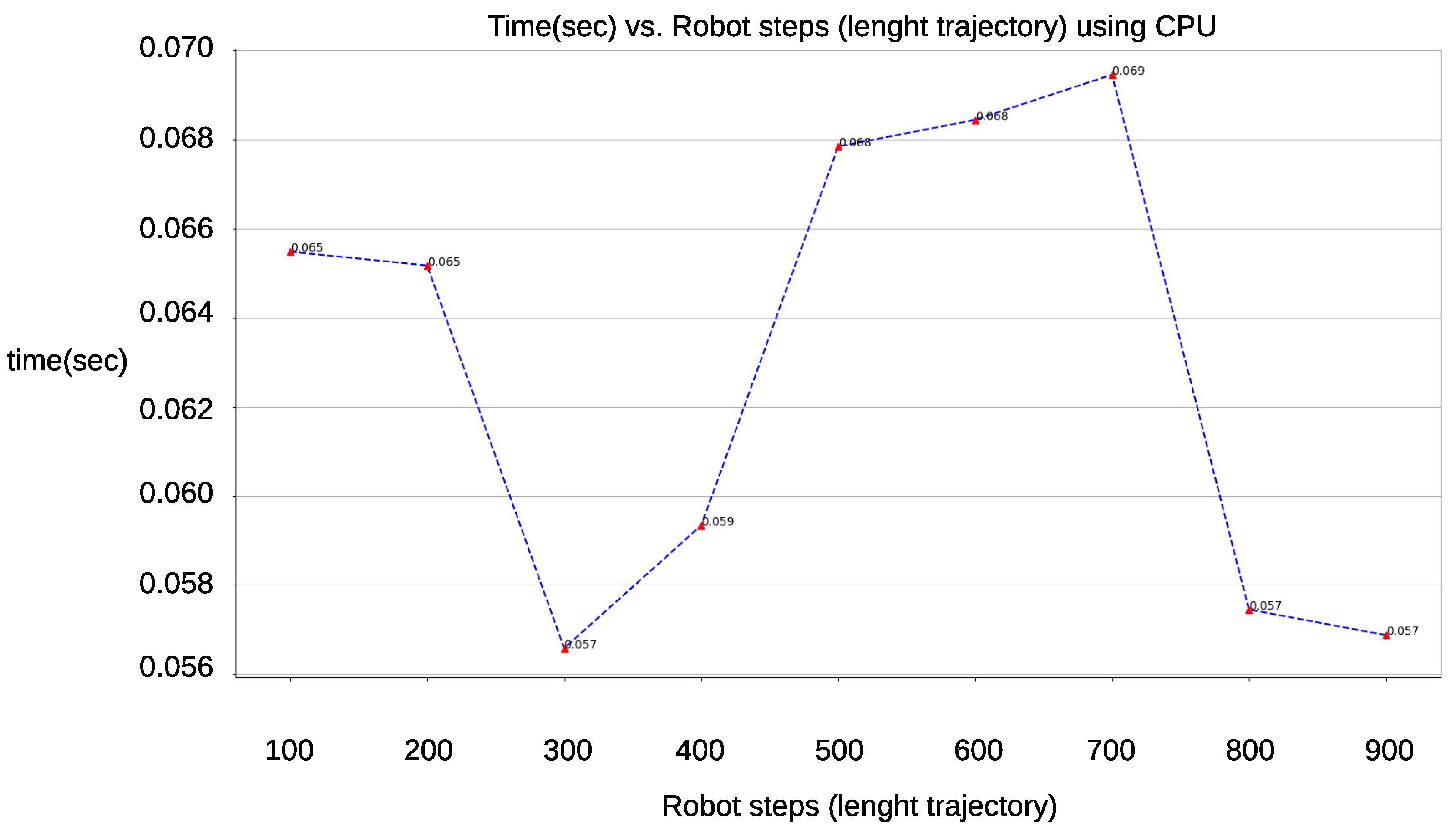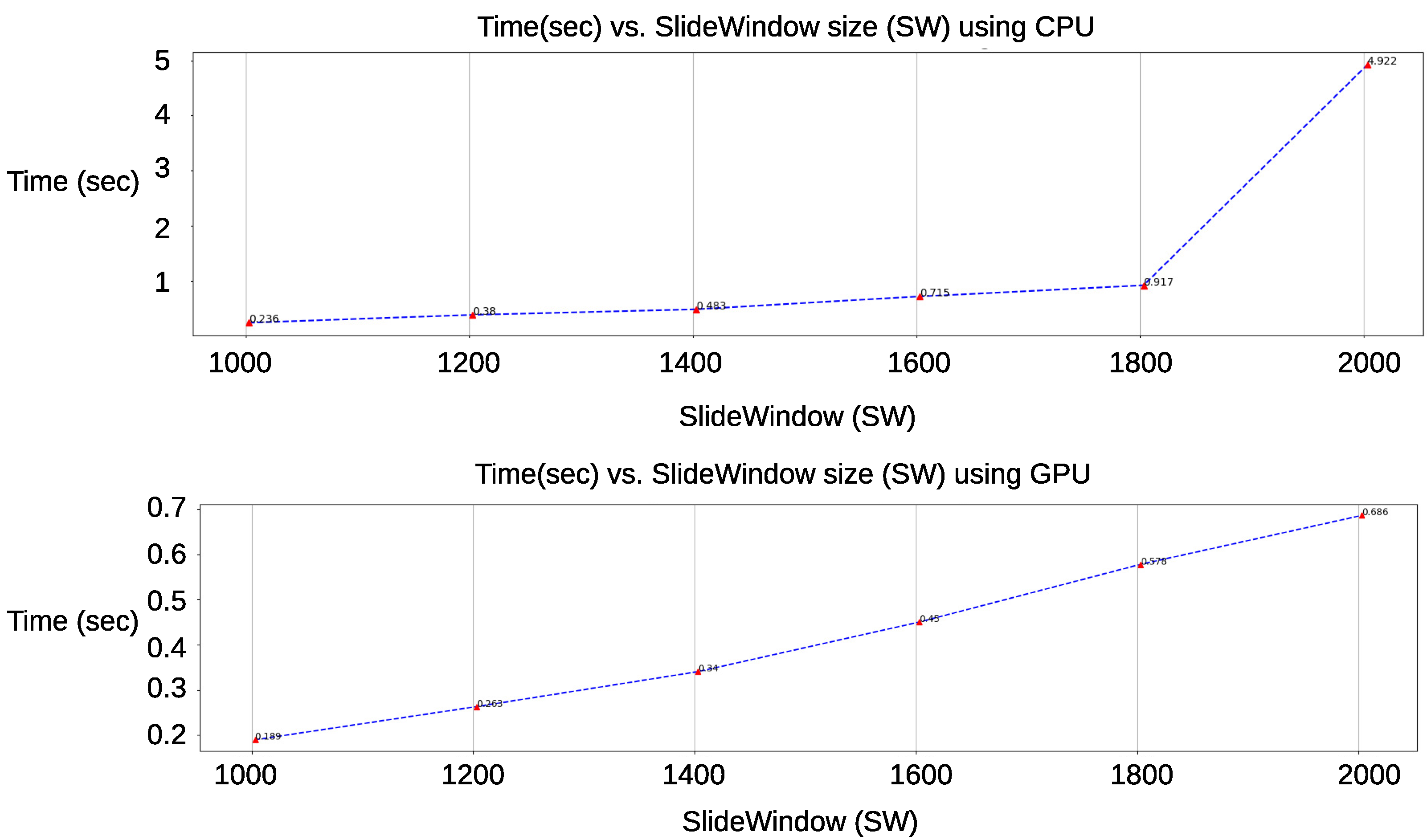1. Introduction
Simultaneous Localization and Mapping (SLAM) is a core problem in robotics and autonomous systems involving the estimation of a robot’s pose (its position and orientation) and the creation of a map of an unknown environment using sensor data. SLAM is inherently complex and typically requires the integration of multiple sensor types, including cameras, LIDAR, and inertial measurement units (IMUs), to yield accurate and reliable estimates of the robot’s pose and the surrounding environment map.
SLAM is commonly framed as a probabilistic inference problem, where the objective is to estimate an optimal robot pose and map by maximizing the posterior probability, based on sensor measurements. Various algorithms exist to solve SLAM, notably the Extended Kalman Filter (EKF) [
1], Particle Filters (PFs) [
2], and Graph-based SLAM [
3].
The EKF (and its variants) and GraphSlam are among the most widely used SLAM algorithms (see examples of applications listed (
https://www.cvlibs.net/datasets/kitti/eval_odometry.php, accessed on 1 November 2024) using [
4,
5]. However, GraphSlam heavily depends on detecting loop closures, which are crucial for correcting accumulated errors but can be challenging to identify. This requires robust and efficient methods to determine when a robot revisits a previously seen location. Additionally, GraphSlam’s complexity can increase quadratically with the number of landmarks and poses in the environment.
Other proposals focus on optimizing the efficiency of the algorithm, as demonstrated in approaches that employ sub-maps [
6,
7,
8]. However, dividing a map into sub-maps can lead to inaccuracies when integrating these sub-maps, as error accumulation across boundaries can disrupt global consistency. Additionally, sub-map management often requires assumptions about independence or minimal correlation between regions, which may not hold in complex or densely featured environments, potentially degrading accuracy. Moreover, while sub-mapping reduces immediate computational load, it can introduce overhead in tracking and updating sub-map boundaries, which becomes particularly challenging in dynamic or large-scale environments. Lastly, the memory required to store and update multiple sub-maps in real-time scales linearly with the number of sub-maps, potentially constraining performance in resource-limited systems.
Recent advancements in the field include approaches that incorporate deep learning, as outlined in [
9]. However, the quasi-analytic solutions derived from the EKF and its SLAM variants remain among the most effective methods currently available [
4,
10]. Deep learning solutions are increasingly applied in Visual SLAM (camera-based data), benefiting from advancements in image and video processing [
11].
The EKF is arguably the most widely used estimation algorithm for nonlinear systems [
12,
13]. A notable variant of the EKF is the Extended Information Filter (EIF); mathematically, the EKF and EIF are equivalent, but EIF matrices link poses and landmarks, which is critical to our proposed method, EIF-SlideWindow.
EIF-SLAM is a recursive algorithm that estimates the robot’s pose and environment map by iteratively updating the state estimate using sensor data. The EIF operates under the assumptions of Gaussian noise and linearity, which may lead to inaccuracies in highly nonlinear systems or in environments with significant non-Gaussian noise. Additionally, the computational complexity of the EIF/EKF can grow substantially with larger environments, resulting in performance issues.
In this paper, we present a novel approach to EIF-SLAM, the EIF-SlideWindow, designed to address these limitations by maintaining accuracy and improving efficiency. Our approach processes each step in constant time, regardless of the trajectory length, making it suitable for real-time scenarios.
Our EIF-SlideWindow approach modifies the EIF algorithm to keep the information matrix and vector at a fixed size. This sliding window is designed to act as a queue, where outdated landmarks are removed, and new ones are inserted as the robot moves, preserving a consistent matrix size along the trajectory. The sliding window is centered on the robot’s current pose, allowing for efficient computation without sacrificing recent information.
It is important to note that our approach does not use the sub-map technique; instead, the environment is treated as a whole, maintaining correlation throughout the entire trajectory. However, we leverage the sliding window concept due to the limited influence of more distant or disconnected points relative to the current points [
14], allowing us to use only a data window that achieves an optimal balance of efficacy and efficiency in the calculations.
We evaluate our proposed method using simulated data and compare its performance to the standard EIF/EKF-SLAM algorithm. Results indicate that our approach improves both accuracy and efficiency. We further demonstrate the real-time capabilities of our approach, highlighting its potential for practical applications.
For experimentation, we developed our code in Python, leveraging PyTorch for efficient matrix operations and compatibility with both CPU and GPU processing. This setup also facilitates future integration with the Python Rosbag package for real-data evaluation.
The rest of this paper is organized as follows:
Section 2 provides a detailed overview of the EIF-SLAM algorithm and its limitations.
Section 3 describes our proposed EIF-SlideWindow approach.
Section 4 presents our experimental results, comparing the performance of our approach with that of the standard EKF and EIF-SLAM algorithms. Finally, in
Section 5, we conclude the paper and discuss future research directions.
2. Extended Information Filters (EIFs)
The Extended Information Filter (EIF) builds on the same mathematical foundation as the Extended Kalman Filter (EKF) to solve the Simultaneous Localization and Mapping (SLAM) problem, but it represents the information in a different form. The EKF extends the standard Kalman filter to handle nonlinear systems, which makes it suitable for SLAM applications. Both the EKF and EIF estimate a posterior distribution over the robot state, denoted by E, which is modeled as a multivariate Gaussian distribution. The posterior distribution is conditioned on previous measurements (e.g., from LIDAR) and past robot motion commands.
The mathematical formulation of the EKF/EIF assumes that measurement errors follow a Gaussian distribution
, whose probability density function, evaluated at
, is given by:
When applying the EKF/EIF to the SLAM problem, the likelihood function seeks to estimate the most probable configuration of the state
E given the robot motion commands and measurements (e.g., LIDAR-based landmark detections). Since we are interested in the maximum-likelihood estimate, rather than the absolute probability values, we can disregard constant factors in Equation (
1). Thus, Equation (
1) simplifies to:
Given the large number of measurements typically available in real-world scenarios (e.g., multiple landmark detections per robot step), a matrix representation is more computationally efficient.
Let represent the robot’s pose at time t, where we define . Here, and are the Cartesian coordinates at time t, and is the robot’s orientation (heading angle) from time to t. Let N denote the total number of landmarks in the environment, with each landmark defined by its Cartesian coordinates , where .
The complete state
E of the environment at time
t can then be defined as:
which can be expanded to:
Equation (
3) represents a vector that includes the robot’s pose at time
t, as well as the coordinates of all landmarks in the environment (see
Figure 1).
Then, the posterior distribution of the robot state is defined as:
where:
denotes the set of observations up to time t, with each observation representing the distance and bearing from the robot’s pose to a landmark , for .
represents the sequence of motion commands up to time t, with each motion command specifying the distance and bearing over the interval , i.e., from pose to .
is the mean of the distribution.
is the covariance matrix.
T denotes the transpose operation.
Starting from Equation (
4), we expand the exponent term, yielding:
Following the simplification used in Equation (
1), the constant term (last term in Equation (
5)) can be removed without affecting the outcome of this development. Thus, we have:
The term
in Equation (
6) is known as the information matrix, denoted by
, and
is called the
information vector, denoted by
. Therefore, we define:
Using this alternative representation, we obtain the Extended Information Filter (EIF) formulation:
Finally, the estimate of the state
can be computed as:
From a mathematical perspective, the EKF and EIF formulations are equivalent. However, the information matrix
is symmetric, and its entries directly correspond to the elements (i.e., poses and landmarks) in the environment.
Figure 2 illustrates the matrix
and its relationships with the robot’s poses and landmarks in the environment.
This property will be crucial in our proposed approach, as the information matrix H and vector b will serve as the basis for the sliding-window EIF.
According to the SLAM process, with each LIDAR measurement, the information matrix H and vector b must be updated as follows:
- 1.
Prediction of the robot pose and covariance S from to t;
- 2.
Update (or correction) of the robot pose and covariance: Adjust the state estimate with the new LIDAR measurements and refine the covariance.
It is worth noting that the entries in
in
Figure 2b do not directly represent coordinates in the environment as shown in
Figure 2a.
In a real-world scenario, the robot operates in a nonlinear environment (such as 2D space with x and y coordinates), which complicates the analytical computation of the Gaussian distribution. To address this, a linearization process is commonly used, making it possible to apply either the Extended Kalman Filter (EKF) or the Extended Information Filter (EIF).
To incorporate both the motion command (between consecutive poses) and LIDAR measurements (between pose and landmark), both quantities must be linearized before updating the information matrix H and vector b.
Following traditional Kalman filter methodology, we approximate nonlinear functions with a first-order Taylor series expansion, replacing the first derivative with the Jacobian matrix of partial derivatives.
We avoid further mathematical details here, which are available in [
15]. However, a critical component of the Kalman filter algorithm is this linearization process, applied in each of the two steps outlined above.
In the first step (motion prediction), the next robot pose is modeled by a deterministic nonlinear function
g plus independent Gaussian noise:
where
is the change from state
to state
,
is a Gaussian random variable with zero mean and covariance determined by the sensor properties (LIDAR or IMU) or manually set for simulated scenarios,
P is a projection matrix that scales
, and
g is the nonlinear function of the robot’s motion.
The function
g can be approximated using a first-degree Taylor series expansion as follows:
where the Jacobian matrix
(also written as
) captures the partial derivatives of
g with respect to the state
E.
In the second step (update or correction), a second deterministic nonlinear function
h plus independent Gaussian noise
is used to model the robot’s measurements, e.g., LIDAR observations:
where
h is similarly approximated by a Taylor series expansion:
Here, and are the Jacobians of g and h, respectively.
Choosing the values of
and
is crucial for accurate linearization of these nonlinear functions. A typical choice is to use the following approximation:
where
represents the displacement in
x,
y, and
from time
to
t, calculated using
. This estimate may lead to drift over time, as errors accumulate with each movement. One solution is to repeat the linearization several times, each time using progressively better estimates to linearize
g and
h, achieving convergence after sufficient iterations [
16].
However, this iterative approach can be computationally expensive, especially during the update step, as each landmark measurement requires a separate linearization and update. The prediction step, on the other hand, involves a single linearization of g.
Finally, we can express H and b for the two steps as follows:
- 1.
Prediction of the robot pose:
- 2.
Update or correction of
and
:
where:
and
is an initial estimate of the robot state, computed as
, with
.
Here, I is the identity matrix with dimensions .
3. Our Proposal: EIF-SlideWindow
As is well known, nonlinear Kalman filter (KF) variants share a common limitation: computational cost and memory requirements grow with the trajectory length, even in environments with limited spatial extent.
Specifically, the update step in the Extended Kalman Filter (EKF), where measurements for N active landmarks are processed at each robot timestep, represents a computational bottleneck.
For the EKF, the dimensions of the observation matrix H and the measurement vector b are determined primarily by the total number of timesteps T and the number of landmarks.
In practical scenarios, two distinct cases may arise:
- 1.
Online Estimation: Data from sensors (e.g., LIDAR) are processed in real-time at each timestep. Here, the final values of T and N are unknown, so H and b grow incrementally as new observations are incorporated.
- 2.
Offline Estimation: All data are collected before processing, so T and N are fixed in advance.
In both cases, significant data volumes must be handled. For instance, a typical LIDAR sensor may capture thousands of points per second, posing challenges in both processing time and memory usage.
This results in a key trade-off for the EKF algorithm and its variants between accuracy, computational load, and memory usage. Reducing the number of landmarks or robot poses over a fixed trajectory length reduces both memory and processing time but at the cost of reduced estimation accuracy and vice versa.
In this paper, we propose a modification to the Extended Information Filter (EIF) algorithm to maintain fixed dimensions for H and b. At each timestep, newly observed landmarks are incorporated and the robot’s current state is updated. To keep the dimensions of H and b constant, we employ a sliding-window approach where older landmarks are removed from consideration as new ones are added. This window centers on the current robot pose, effectively maintaining a fixed-size state representation over the entire trajectory.
Figure 3 illustrates the sliding window (highlighted in blue) associated with a robot pose (indicated by a circle) at time
t. As shown in
Figure 3, the state
consists of the current robot pose and the landmarks within the window (see Equation (
3)).
This strategy aims to achieve constant processing time as the robot continues its measurements along its path.
To mitigate the potential loss of accuracy due to reduced constraints (i.e., fewer landmarks), the time saved can be reallocated to enhancing the linearization process, particularly during the prediction step, which has the potential to significantly improve estimation accuracy. However, it is important to note that this aspect has not been explicitly explored within the scope of the current work.
3.1. Size of Sliding Window
At each robot pose, a large set of landmarks in the environment is detected. However, only a fixed subset is associated with each pose for use in the EIF algorithm. The number of landmarks associated with each pose depends on factors such as computational power, available memory, and the desired accuracy or error in the trajectory estimation.
By adjusting the sliding window size, these variables (computing load, accuracy, and memory usage) can be balanced. In real-time applications, the sliding window size is often constrained by available memory and computational resources.
We define the sliding window size
as:
where
is the number of landmarks selected per pose step,
k is the number of previous robot steps,
is the dimension of the robot state vector, and
is the dimension of the measurement vector. For example, in a planar setting,
and
, where the robot features vector
p is
and the measurement features vector
l is
.
Using
, we can now define the dimensions of
H,
b, and the state vector as follows:
Thus, determines the dimensions of H, b, and the state vector for the EIF-SlideWindow algorithm.
3.2. Updating H, b, and E According to the Sliding Window Size
In our approach,
updating refers to the process of
,
, or
operations on a matrix or vector. Specifically, we define these operations as follows:
where
is the set of landmarks associated with the current robot pose. This
task incurs minimal computational cost.
Note that until the number of robot steps reaches
k (as defined in Equation (
17)), no updating is performed. Once updating begins on
H,
b, and the state vector, the oldest block of landmarks of size
is removed, and the remaining blocks are shifted to make room for the new landmark block.
Figure 4,
Figure 5 and
Figure 6 illustrate the updating process for the state vector, vector
b, and matrix
H, respectively.
Algorithm 1 presents a detailed pseudocode of our proposed algorithm, EIF-SlideWindow, closely following the structure of the corresponding Python implementation. We incorporate both mathematical notation and Python-style pseudocode to enhance clarity and facilitate understanding of the algorithm’s logic and flow. Line 19 performs the
process, while lines 24 to 31 carry out the prediction step, during which the linearization process can also be refined.
| Algorithm 1 EIF-SlideWindow Algorithm |
Require:- 1:
Commands →. - 2:
, landmarks number by pose. - 3:
k, number of robot previous steps - 4:
Landmarks from a robot step
Initialize:
- 5:
, , - 6:
= , - 7:
State , insert and - 8:
Simple estimate State - 9:
Information matrix - 10:
Information vector - 11:
Covariance Motion - 12:
=0, → - 13:
Covariance measurements - 14:
(=0, → - 15:
while NULL do - 16:
- 17:
- 18:
- 19:
if then - 20:
- 21:
- 22:
else - 23:
and - 24:
end if - 25:
while do ▹ Prediction and linearization - 26:
- 27:
- 28:
- 29:
[2,0:2]= - 30:
- 31:
- 32:
- 33:
end while - 34:
for each do l is x,y ▹ measure Update - 35:
if l is considered from this robot pose then - 36:
- 37:
=(); - 38:
= dist=(); - 39:
C= - 40:
:−1, = diff/d diff=; d=() - 41:
= −(diff/d) is the index of l in C - 42:
−1, = [−diff[1]/, diff[0]/] - 43:
= [diff[1]/, −diff[0]/] - 44:
−1, = −1 - 45:
- 46:
- 47:
end if - 48:
end for - 49:
- 50:
- 51:
end while
|
4. Experimental Design
To validate our proposal, we present results that demonstrate its accuracy and efficiency through the use of simulated data, offering a controlled environment for rigorous evaluation. This methodology enables benchmarking across a range of predefined scenarios, ensuring that the algorithm adheres to established performance standards. By leveraging simulations, we can conduct a comprehensive assessment, allowing for refinement and optimization prior to real-world implementation.
The experiments were conducted on a computer with the following specifications:
Using the pseudocode in Algorithm 1, we developed an implementation of the EIF-SlideWindow algorithm in Python. To optimize performance, particularly for matrix operations, we leveraged the PyTorch library, allowing us to utilize both CPU and GPU processing for comparative analysis.
To evaluate trajectory estimation accuracy and computational efficiency, we employed the Extended Kalman Filter (EKF) and the standard Extended Information Filter (EIF) as reference benchmarks. The code for the EKF and EIF, along with parameter initialization, was obtained from [
15] (
https://github.com/theevann/SLAM, accessed on 1 November 2024). This setup enables direct comparison with validated implementations, and all algorithms were executed under identical hardware conditions to ensure a fair comparison.
In accordance with [
15], the following parameters were defined:
Dimension of robot state: ; dimension of measurement features: .
Number of active landmarks per robot step: , as specified in line 33 of Algorithm 1.
Length of the trajectory (number of robot steps): .
Command for robot motion: , where and .
Number of iterations for linearization: , as we do not consider iterations to improve linearization in these experiments.
It is important to distinguish between and . In this context, refers to the number of landmarks accepted (true) in line 33, while denotes the number of landmarks selected by each robot step, typically derived from LIDAR measurements.
During each robot pose update, landmarks are measured from the surrounding environment. In this implementation, landmarks are distributed around each pose within an area of approximately 100 m, consistent with standard LIDAR configurations.
To assess the accuracy of the estimated trajectory, we utilize the Root Mean Square Error (RMSE), specifically the RMSE between the estimated trajectory and the actual motion. We employ the Python package evo [
17] for this purpose (
https://github.com/MichaelGrupp/evo, accessed on 1 November 2024).
Initially, it is crucial to understand the accuracy behavior for varying slide window (SW) sizes.
Figure 7 illustrates the results of accuracy (RMSE) as the size of
is incrementally increased.
Note that with each iteration, where the slide window (SW) size is fixed, a trajectory consisting of 100 steps is generated. Each trajectory is distinct because the robot’s motion is determined by a random command
u (see
Figure 8). Furthermore, the minor variations in RMSE observed for
can be attributed to the random Gaussian noise added to both motion and measurement processes. Notably, the RMSE for the EIF-SlideWindow algorithm stabilizes when
.
On the other hand, we need to compare our approach with the results obtained from the EKF and EIF algorithms. Given our approach, it is reasonable to anticipate a decrease in accuracy due to the utilization of fewer landmarks. As in the previous experiment, we adhere to the parameters established in [
15], as defined above.
Table 1 presents the results obtained.
From
Table 1, we observe that our proposal yields superior results in trajectory estimation. This improvement may stem from the fact that the number of active landmarks per robot pose (as indicated in line 32 of Algorithm 1) is fixed to manage computational costs across all algorithms in the state of the art. This constraint on accuracy arises from not utilizing all available landmarks. However, it is important to note that an abundance of non-active landmarks may adversely affect accuracy.
Our experimental results indicate a relationship among the number of active landmarks, the slide window size
(which corresponds to the size of the information matrix
H), and the RMSE (see
Figure 9). It is evident that achieving a stable minimum RMSE while increasing the number of active landmarks necessitates a corresponding increase in
.
Additionally, from
Figure 7 and
Table 1, we can conclude that our approach demonstrates improved accuracy compared to the EKF for values of
.
The next aim is to evaluate the efficiency of the EIF-SlideWindow algorithm. In this case, we observe that the algorithm maintains a constant processing time regardless of trajectory length, given that both the slide window (SW) and the number of landmarks (
) are fixed.
Figure 10 illustrates the results for robot trajectories ranging from 100 to 1000 steps, with
and
.
Finally, we highlight the advantages of utilizing a GPU. When using the CPU, the processing time increases exponentially after
(see
Figure 11, top). In contrast, the GPU exhibits a linear increase in processing time (see
Figure 11, bottom). Specifically, we compute the average processing time (in seconds) for each robot pose in a trajectory, with
fixed. According to Algorithm 1, this average time accounts for all iterations between lines 15 and 48, which correspond to a single trajectory.
4.1. Performance Considerations in Complex Environments
The sliding window approach offers distinct advantages and potential limitations in moderately complex environments. By maintaining a fixed-size state representation focused on recent poses and landmarks, it ensures computational efficiency and real-time performance by reducing memory and processing demands. In environments with moderate landmark density or overlapping features, the constrained representation may reduce accuracy by excluding global correlations. However, its adaptability to local data makes it effective in scenarios where complexity challenges global methods but remains manageable for local optimization. This balance highlights its practical benefits and areas for adaptation. Additionally, retaining the entire trajectory in RAM or physical memory (see Algorithm 1 line 49) enables retrieval and reinsertion to updates process (lines 20, 21).
4.2. EIF-SlideWindow: Parameterization and Design Guidelines
The window size in the EIF-SlideWindow algorithm directly affects its performance, balancing computational load, estimation accuracy, and adaptability to environmental characteristics. A larger window size retains more landmarks and historical data, which should improve global correlation and trajectory consistency, particularly in environments with dense or overlapping features. However, this comes at the cost of increased computational and memory demands, potentially hindering real-time performance. Conversely, a smaller window size reduces computational overhead and enhances efficiency but may sacrifice accuracy in complex environments by excluding critical correlations.
4.2.1. Relationship with Environmental Characteristics
Environmental complexity plays a pivotal role in determining the optimal window size. For sparse environments with well-separated landmarks, a smaller window suffices, as the reduced density minimizes the risk of losing important correlations. In contrast, medium-to-high-complexity environments, where landmarks are denser or feature overlaps occur, benefit from larger windows to maintain trajectory consistency and accurate mapping.
4.2.2. Computational Load Considerations
The computational load increases quadratically with the window size due to the dimensions of the associated matrices, such as H and b. Larger windows necessitate greater computational resources and may require high-performance hardware for real-time applications. The sliding window approach ensures that computational demands remain predictable, enabling system designers to select a window size appropriate for the available resources.
4.2.3. Design Guidelines
To balance accuracy and efficiency, we propose the following design guidelines:
- 1.
Assess Environmental Complexity: Choose larger windows for dense or overlapping features and smaller windows for sparse settings with minimal landmark interaction.
- 2.
Consider Computational Resources: Ensure the window size aligns with the available hardware capabilities, particularly for real-time implementations.
- 3.
Optimize Landmark Selection: Implement heuristics or prioritization strategies to ensure that the landmarks selected within the sliding window maximize informational gain and contribute effectively to the accuracy of the algorithm.
5. Conclusions and Future Work
This paper has delved into the workings of the EIF-SlideWindow algorithm, an approach within the field of Simultaneous Localization and Mapping (SLAM). EIF-SlideWindow represents a significant advance in addressing challenges typically encountered in SLAM algorithms. By leveraging the Extended Information Filter, the EIF-SlideWindow algorithm achieves improved efficiency and accuracy, demonstrating a capacity for constant-time performance across varying trajectory lengths.
The EIF-SlideWindow algorithm provides robust solutions to critical issues such as computational complexity and real-time operation constraints, enhancing the viability of SLAM for autonomous systems. The experimental results illustrate the method’s effectiveness in maintaining accuracy while controlling computational overhead, especially when compared to traditional EKF and EIF approaches.
Future work will focus on validating this approach with real-world datasets and exploring the effects of increased iterations on the linearization process to further refine accuracy. For dynamic or varying environments, future development will aim to incorporate mechanisms for adapting the window size based on observed changes in landmark density or environmental conditions. These efforts will aim to expand the robustness and application of EIF-SlideWindow in diverse, real-time autonomous systems environments.
